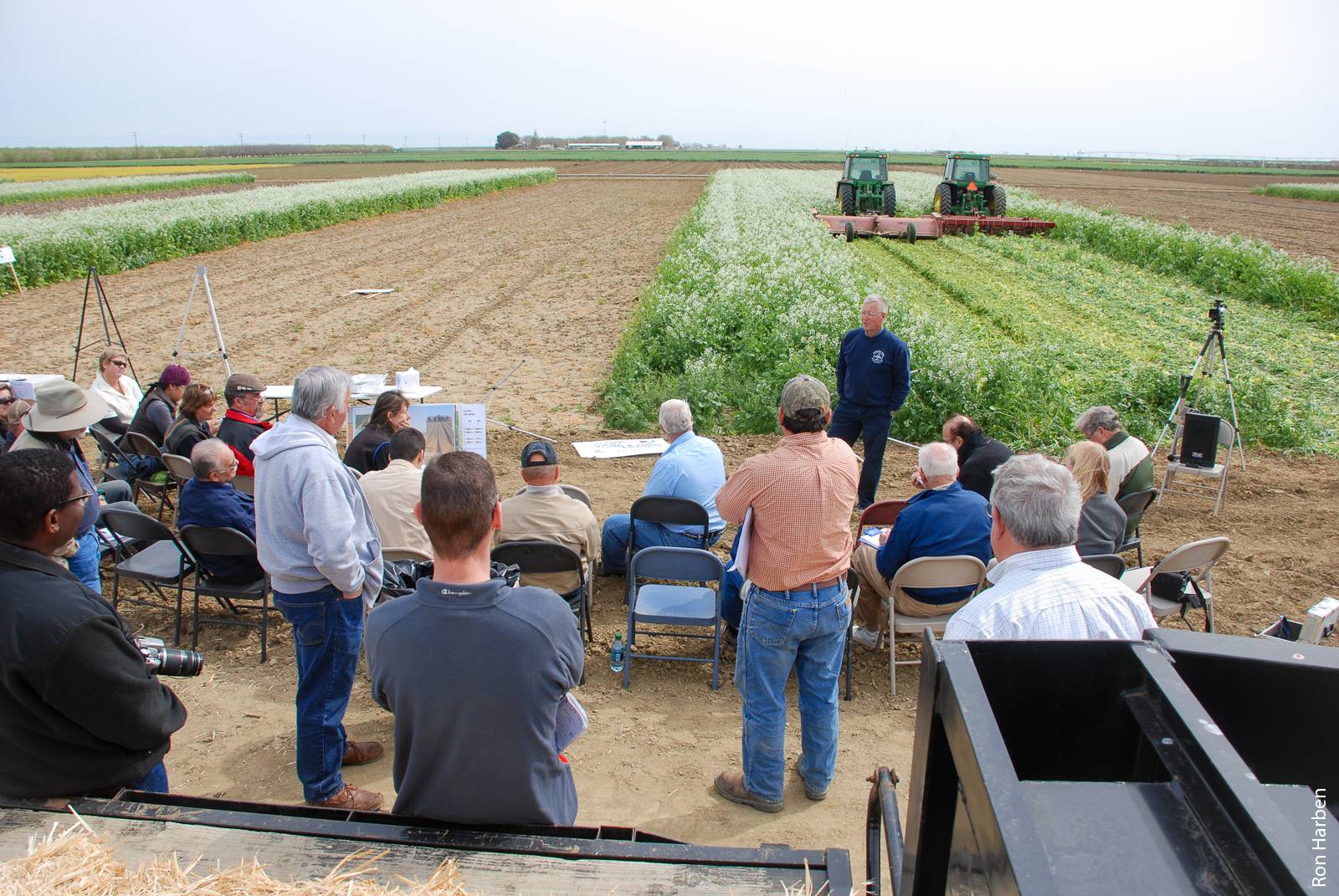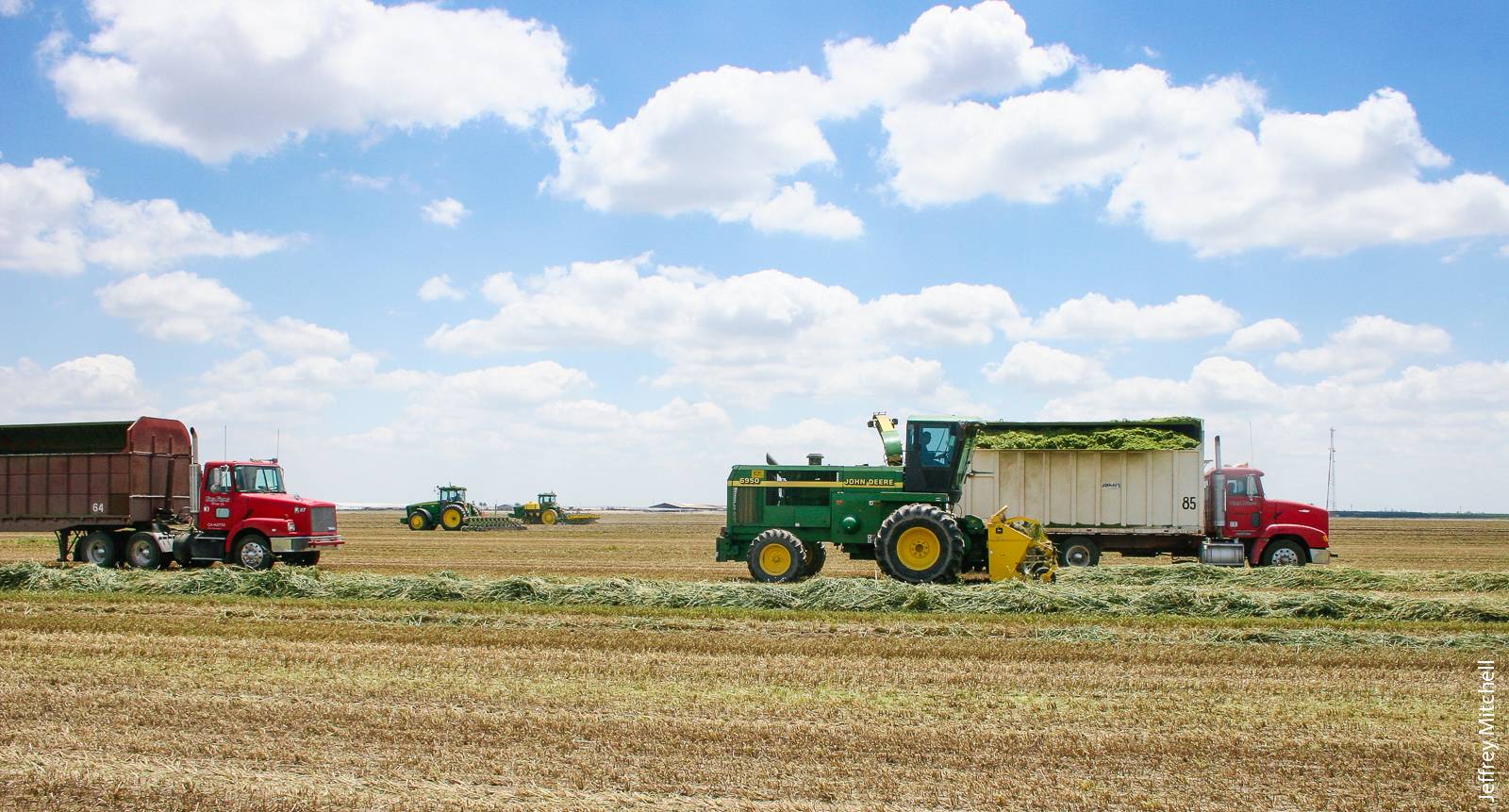All Issues
Conservation agriculture: Systems thinking for sustainable farming
Publication Information
California Agriculture 70(2):53-56. https://doi.org/10.3733/ca.v070n02p53
Published online April 01, 2016
Full text
California is an unquestioned global leader in the productivity of its farms and the diversity and quality of its crops. However, there are significant threats to the sustainability of the state's agricultural systems. The scarcity of water has received great attention in recent years, but that is just one of many concerns. Fossil fuel use, carbon emissions, nitrate pollution of groundwater, labor cost and availability, air pollution and loss of soil fertility all present challenges to the long-term viability of farming in California.
Conservation agriculture can help to address all of these issues. Fundamentally, conservation agriculture is about “kindly use” of the land, to quote farmer-essayist Wendell Berry. It is based on three principles: reducing soil disturbance (tilling less, or not at all), retaining crop residues on the soil surface year-round and fostering crop and soil biodiversity. By designing farming systems around these principles, our work has shown that farmers can save water, store more carbon in the soil, burn less fossil fuel, cut labor costs, lower dust emissions and increase profits.
Despite conservation agriculture's promise, however, its adoption has been slow in California. In the Midwest and Great Plains regions, conservation agriculture is practiced on more than 30% of cropland, compared with less than 5% of annual cropland in California. As founders and members of the Conservation Agriculture Sustainability Innovation center (CASI), we are partnering with California farmers and equipment makers to develop conservation agriculture practices and technologies that are effective and appropriate for the state's production systems, and to build networks to help their adoption.
In 2010, CASI held a public education event on cover crops for farmers and private sector, UC and NRCS participants at the UC ANR West Side Research and Extension Center in Five Points.
The magnitude of the benefits possible with conservation agriculture is striking. A few examples:
-
Water: No-till, surface mulching practices and increases in soil organic matter can reduce soil water evaporation by 4 to 5 inches annually (Klocke et al. 2009; Mitchell, Singh et al. 2012; van Donk et al. 2010) and increase soil water storage capacity by the equivalent of roughly 2 inches (Franzluebbers 2010; Hudson 1994). If applied on a significant amount of California's roughly 8.5 million acres of irrigated lands, these measures could reduce statewide irrigation demand by millions of acre-feet.
-
Cost: By limiting tractor passes and other operations, reduced-tillage practices cut production costs by $100 to $150 per acre across a range of crops grown in California (Mitchell, Carter et al. 2012; Mitchell, Klonsky et al. 2012).
-
Carbon: In a long-term tomato-cotton rotation study in the San Joaquin Valley, after 15 years of reduced tillage in combination with cover cropping, soil carbon content doubled in the top 6 inches of the soil profile (Mitchell et al. in review). Implemented broadly, these practices could be a major new tool in California's efforts to reduce net greenhouse gas emissions.
-
Particulate matter: Air pollution is a major concern in the San Joaquin Valley and other agricultural regions. Compared with standard tillage, conservation tillage can reduce by 85% the emissions of fine dust particles (PM10 — particulate matter less than 10 microns in diameter), as demonstrated in a study of a dairy forage system (Madden et al. 2008).
Yet there are good reasons why conservation agriculture has, to date, not been adopted widely in California.
First, shifting to a conservation agriculture approach requires investments in technology (primarily irrigation and planting equipment), changes in how a farm is managed, and a transition period of several years for soil health and its benefits to develop — each of which introduces risks for farmers. Knowledge gained through the shared experiences of farmers and agricultural specialists helps to reduce those risks and ease the process of adoption. In California, while there are a number of notable conservation agriculture pioneers, the network of farmers who can share their experiences is still relatively small.
Second, conservation agriculture practices were largely developed and refined on corn, soybean, wheat and cotton farms in the Midwest and Great Plains; a key driver was the opportunity to reduce soil erosion from sloping fields. For those systems, conservation agriculture equipment and guidance are abundant. California — with its Mediterranean climate, largely flat farming landscapes, and diverse mix of crops and soil types — has very different farming systems, meaning that conservation agriculture equipment and techniques need to be adapted to work here, or in some cases developed from scratch. That adaptation and innovation requires research and development.
Benefits of conservation agriculture systems
Research conducted by CASI has demonstrated a number of economic and environmental benefits that are achieved when conservation agriculture practices are used, including
-
Tillage costs typically reduced by $40 to $150 per acre
-
Lower fuel use
-
Reduced farm energy use
-
Reduced dust emissions by 50% to 80%
-
Increased soil carbon levels
-
Lower soil water evaporation
-
More diverse and abundant soil biology
-
Increased carbon capture in the production system
-
Increased soil aggregation
-
Increased irrigation application efficiency and uniformity
-
Biologically fixed nitrogen added to the soil, and
-
Less surface water runoff
To address these two related challenges — adoption and innovation — CASI was founded in 1998, beginning as a workgroup within UC Agriculture and Natural Resources and growing to include more than 2,200 partners, including hundreds of farmers, private firms, and researchers and other staff from the UC and California State University (CSU) systems, the U.S. Department of Agriculture — both the Natural Resources Conservation Service (NRCS) and the Agriculture Research Service — and environmental groups.
As a result of the activities of these individuals and groups, conservation agriculture practices are well established for a number of California crops, and the necessary equipment is available. These crops include corn, sorghum, wheat, triticale, forages, cotton, beans and processing tomatoes.
For these crop systems, our focus at CASI is on outreach. We are working to expand partnerships with the private sector to train trainers and get innovation into the hands of farmers. Support from these partners — in particular California Ag Solutions, Wilcox Agriproducts, Reinke Manufacturing Co., Senninger Irrigation, Valmont Industries, Lindsay Corp. and Orthman Manufacturing — has been invaluable.
In addition, we are developing regional centers for demonstration and innovation. In these partnerships — between local farmers, UC and CSU researchers, resource conservation districts and NRCS — farmers work with researchers to establish comparison plots to evaluate conservation agriculture practices. These demonstration sites, currently in place in Fresno, Kern, Mendocino, Sacramento and Stanislaus counties, provide valuable research results, while also establishing sites where farmers can learn from CASI experts and from each other.
Our long-term goal is for CASI to become a true farmer-led organization, following the example of successful conservation agriculture partnerships elsewhere, such as No Till on the Plains and the Pacific Northwest Direct Seed Association .
In addition to outreach, there's a continuing need for research and innovation, both to improve equipment and management practices and to understand and optimize system-level processes such as crop sequences.
CASI farmers and members visited South Dakota, Nebraska and Colorado in 2006 to learn about conservation agriculture systems. Here, participants tour the Dakota Lakes Research Farm, a research and extension center of South Dakota State University, in Pierre.
There is a need for more cost-benefit data on conservation agriculture practices across a range of California crop systems. Research on ways to increase the amount of water in the soil that is transpired by crops rather than lost to evaporation could lead to water-saving farming methods. Experiments could help to determine how best to combine multiple conservation practices — for instance, reduced tillage, surface residue preservation and precision irrigation (see research article this issue).
We are also working to expand the scope of conservation agriculture into cropping systems for which it was previously unthinkable. Lettuce is a good example. While it is daunting to consider how conservation agriculture practices might be applied to such a high-precision, high-value, rapid-turnover crop, there are large potential payoffs in improved soil health, reduced fuel, water and fertilizer inputs, reduced dust emissions and more. With all this in mind, in January we held a planning meeting with several farmers to discuss developing conservation agriculture for lettuce systems.
Examples from around the nation and the world help to expand our notions of what can be achieved: 60% of Brazil's tomatoes, for instance, are farmed without tillage. Many of the crops grown in California are successfully produced elsewhere using no- or greatly reduced tillage techniques. Virtually all of the wheat in Western Australia, much of the small grain in Canada and the Great Plains, and a sizable proportion of cotton, corn and bean production in the Midwest and Southeastern United States is produced using no-till and strip-till practices. It may be beneficial to bring techniques and concepts used in those systems to California. CASI's connections with farmers in these diverse regions help us to learn about such global innovations and how they may be successfully scaled up here.
We are heartened by the growing official recognition of conservation agriculture. In his 2016–2017 state budget, Gov. Jerry Brown has called for $20 million to support the California Healthy Soils Initiative. The NRCS soil health campaign, launched in 2012, is supporting education and outreach efforts nationwide, while a just-concluded meeting of the Board on Earth Sciences and Resources of the National Research Council focused on new research policy and federal funding initiatives to improve soil carbon sequestration in the face of climate change. At UC Davis we have proposed the creation of a Systems Agronomy Institute that would position the university as a national leader in conservation agriculture innovation and learning, supporting the state and federal soil health initiatives with research and outreach.
Moving forward, CASI will continue to harness the skills and resources of researchers, farmers and private sector and government partners. Our broad and growing network is committed to continuing the expansion of conservation agriculture practices in California for the sustainability of our farms and the benefit of the state's environment and economy.







